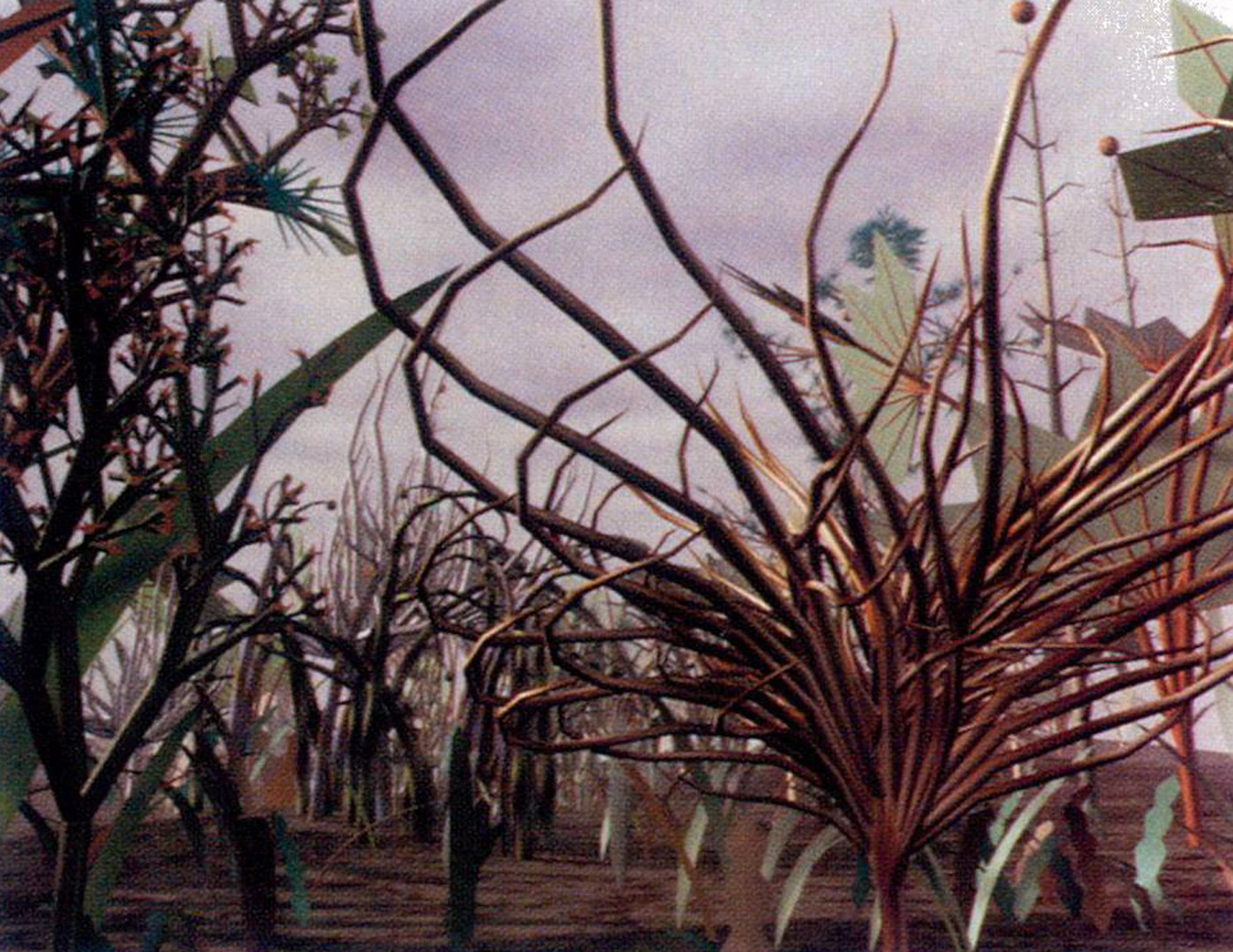“Artificial evolution for computer graphics” by Sims
Conference:
Type(s):
Title:
- Artificial evolution for computer graphics
Presenter(s)/Author(s):
Abstract:
This paper describes how evolutionary techniques of variation and selection can be used to create complex simulated structures, textures, and motions for use in computer graphics and animation. Interactive selection, based on visual perception of procedurally generated results, allows the user to direct simulated evolutions in preferred directions. Several examples using these methods have been implemented and are described. 3D plant structures are grown using fixed sets of genetic parameters. Images, solid textures, and animations are created using mutating symbolic lisp expressions. Genotypes consisting of symbolic expressions are presented as an attempt to surpass the limitations of fixed-length genotypes with predefined expression rules. It is proposed that artificial evolution has potential as a powerful tool for achieving flexible complexity with a minimum of user input and knowledge of details.
References:
1. Aono, M., and Kunii, T. L., “Botanical Tree Image Generation,” IEEE Computer Graphics and Applications, Vol.4, No.5, May 1982.
2. Darwin, Charles, The Origin of Species, New American Library, Mentor paperback, 1859.
3. Dawkins, Richard, The Blind Watchmaker, Harlow Logman, 1986.
4. Dawkins, Richard, “The Evolution of Evolvability,” Artijicial Life Proceedings, 1987, pp.201-220.
5. Goldberg, D. E., Genetic Algorithms in Search, Optimization, andMachine Learning, 1989, Addison-Wesley Publishing Co.
6. Grenfcnstette, J. J., Proceedings of the First International Conference on Genetic Algorithms and Their Applications, Hiilsdale, New Jersey, Lawrence Erlbaum Associates, 1985.
7. Grenfenstette, J. J., Genetic Algorithms and Their Applications: Proceedings of the Second International Conference on Genetic Algorithms, 1987, (Hillsdale, New Jersey: Lawrence Erlbaum Associates.)
8. Haase, K., “Automated Discovery,” Machine Learning: Principles and Techniques, by Richard Forsyth, Chapman & Halt 1989, pp.127-155.
9. Haggerty, M., “Evolution by Esthetics, an Interview with W. Latham and S. Todd,” IEEE Computer Graphics, Vol. I l, No.2, March 199 I, pp.5-9.
10. Hillis, W. D., “The Connection Machine,” Scientific American, Vol. 255, No. 6, June 1987.
11. Holland, J. H., Adaptation in Natural and Artificial Systems, Ann Arbor, MI: University of Michigan Press, 1975.
12. Koza, J. R. “Genetic Progranuning: A Paradigm for Genetically Breeding Populations of Computer Programs to Solve Problems,” Stanford University Computer Science Department Technical Report STAN-CS-90-1314, June 1990.
13. Koza, J. R. “Evolution and Co-Evolution of Computer Programs to Control Independently Acting Agents,” Conference on Simulation of Adaptive Behavior (SAB-90) Paris, Sept.24- 28, 1990.
14. Lenat, D. B. and Brown,J.S. “Why AM and EURISKO a~ to work,” Artificial intelligence, Vol.23, 1984, pp.269-294.
15. Lewis, J. P., “Algorithms for Solid Noise Synthesis,” Computer Graphics, Vol.23, No.3, July 1989, pp.263-270.
16. ~eimer, P. “Real time design and animation of fractal plants and trees.” Computer Graphics, Vol.20, No.4, 1986, pp.55-64.
17. Oppenheimer, P. “The Artificial Menagerie” Artificial Life Proceedings, 1987, pp.251-274.
18. Peachy, D., “Solid Texturing of Complex Surfaces,” Computer Graphics Vol. 19, No.3, July 1985, pp.279-286.
19. Perlin, K., “An Image Synthesizer,” Computer Graphics, Vol. 19, No.3, July 1985, pp.287-296.
20. Perlin, K., “Hypertexture,” Computer Graphics, Vol.23, No.3, July 1989, pp.253-262.
21. Prusinkiewicz, P., Lindenmayer, A., and Hanan, J., “Developmental Models of Herbaceous Plants for Computer Imagery Purposes,” Computer Graphics, Vol.22 No.4, 1988, pp. 141- 150.
22. Reffye, P., Edelin, C., Francon, J., Jaeger, M., Puech, C. “Plant Models Faithful to Botanical Structure and Development,” Computer Graphics Vol.22, No.4, 1988, pp. 151-158.
23. Schaffer, J. D., “Proceedings of the Third international Conference on Genetic Algorithms,” June 1989, Morgan Kaufmann Publishers, Inc.
24. Sims, K., Panspermia, Siggraph Video Review 1990.
25. Smith, A. R., “Plants, Fractals, and Formal Languages,” Computer Graphics, Vol.18, No.3, July 1984, pp.l-10.
26. Steele, G., Common Id’sp, The Language, Distal Press, 1984.
27. Thinking Machines Corporation, Connection Machine Model CM-2 Technical Swnmary, technical report, May 1989.
28. Todd, S. J. P., and Latham, W., “Mutator, a Subjective Human Interface for Evolution of Computer Sculptures,” IBM United Kingdom Scientific Centre Report 248, 1991.
29. Viennot, X., Eyrolles, G., Janey, N., and Axques, D., “Combinatorial Analysis of Ramified Patterns and Computer Imagery of Trees,” Computer Graphics, Vol.23, No.3, July 1989, pp.3~-4o.





